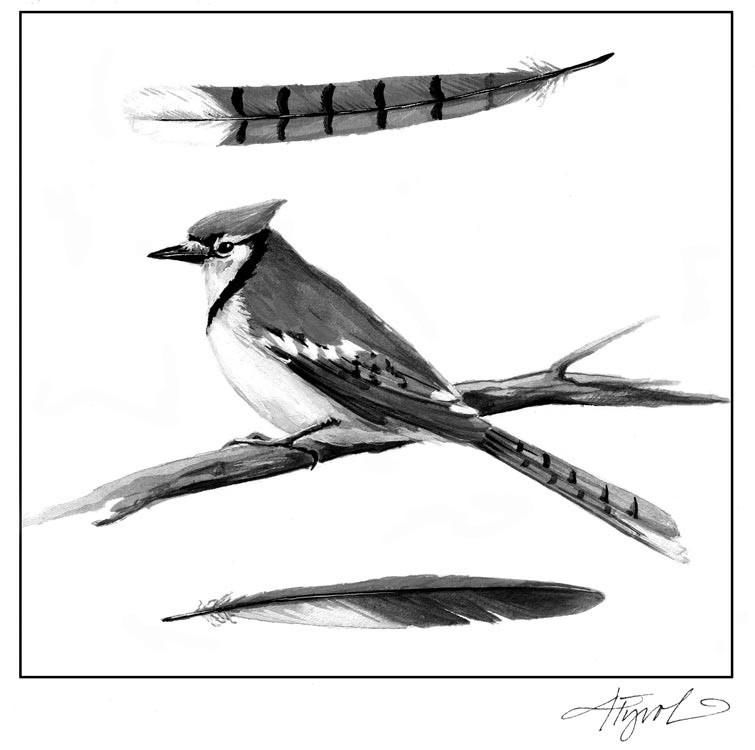
If you flat your third and seventh notes, you can play the blues. Sadness creates a blue mood. A blue pigment gives us blue jeans. Then there is the blue jay’s blue. It’s not a blue pigment that makes a blue jay blue – it’s not even a blue mood. Scientists have long known that the blue jay’s blue is a “structural color” that comes from tiny features in its feathers and skin.
It was only recently, though, that a scientist (with help from a mathematician) figured out exactly how feathers and skin make a blue jay – and other blue birds – blue. That may be because some pretty serious physics is involved in the explanation, and serious physics can drive even ornithologists, the scientists who study birds, screaming from the room.
We’ll try to avoid that screaming here. I promise, no math equations. And if the words “molecules,” “light waves,” or “electron microscope” make you feel a little dizzy, I don’t blame you. Just remain calm and take a deep breath.
First, let’s start with what a blue jay doesn’t have: blue pigment. Pigment is simply stuff that gives something color. Pigment makes my hair brown and a male cardinal red. There is more green pigment than anything in summer leaves, and pigments for red, yellow, and orange predominate in those leaves in the fall. But there is no blue pigment in a blue jay’s wing. Nor is there blue pigment in any bird that appears blue.
How can this be? Well nature has another set of tricks for coloration called “structural color.” Structural colors come from the way materials reflect (like a mirror), refract (like a prism), and scatter light, but not from pigment.
We see a wonderful example of structural color almost every day: the sky. The blue color of the sky is caused by light waves scattering through randomly arranged molecules in the atmosphere. Blue light waves are short, so they scatter the most among the air’s small oxygen and nitrogen molecules, making the sky appear blue. (I could tell you that this phenomenon is called “Rayleigh scattering,” but you might start screaming.)
Other examples of structural color are found in oil slicks and soap bubbles. In an oil slick, for example, the blue is caused not by random scattering but by the light waves reflecting together in just the right way. (That effect is called coherent light scattering or constructive interference.)
For a hundred years, scientists believed that the blue color in birds – especially those with a soft blue hue, such as blue jays, bluebirds, and indigo buntings – was created through Rayleigh scattering. It was a poetic idea: the blue of the sky and the birds was created in the same way.
Close-up looks at the proteins in the birds’ feathers and skin seemed to back up that idea. Under the microscope, the protein structures in the blue birds’ feathers and skin looked pretty random, with air bubbles scattered about almost like the holes in Swiss cheese.
But a few years ago, an ornithologist named Richard Prum (at the University of Kansas) took an even closer look at these structures. He asked Rodolfo Torres, a mathematician at his university, to model what light waves would do when they hit a blue bird’s skin and feathers based on the view through an electron microscope.
Torres found that while the structures looked pretty random, they actually reflected light together in just the right way, creating coherent light scattering as found in an oil slick. Not only that, but, according to his analysis, the color that should be reflected was blue.
Prum repeated the exercise with feathers from 30 species of tropical birds (probably so many because, hey, he wasn’t doing the math) and found that different levels of order in the protein structure created different colors, ranging from the partially ordered structure of blue, to a slightly more organized pattern for white, to a closely packed structure for an “iridescent mirror” effect.
Similar reflections from under the surfaces of animal tissues could also explain the blue of dragonflies and the colored glow reflected by animals’ eyes at night, called eye-shine. Interesting subjects, but don’t wait around for Prum, ever the ornithologist, to take them on. It’s not that he’s afraid of physics. (He’s the one that didn’t run screaming from the room, remember.) It’s just that, as a magazine quoted him as saying several years ago, he couldn’t wait to get back to his bird studies.

